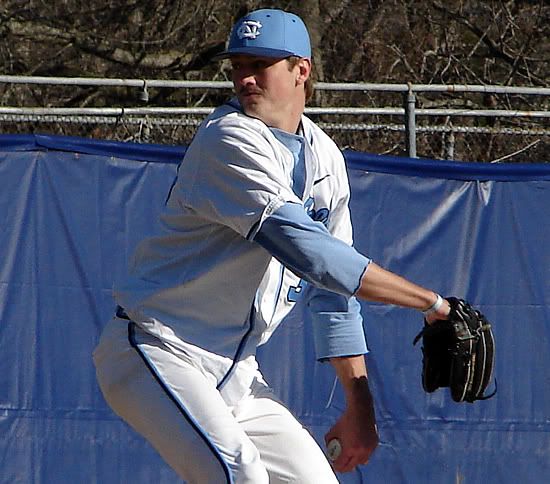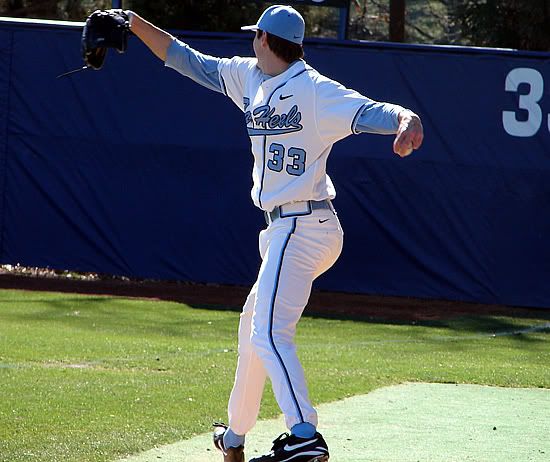RC reports on Andrew Miller...

As promised, we are proud to present our scouting report on Andrew Miller. We initially planned to discuss Daniel Bard as well in this post, but we'll give you our take on his first start of the season either tomorrow or Wednesday. Also, a slight snag has caused us to delay the launch of our Top 10 draft prospects feature, but that too will be unveiled in the next couple days.
Miller left the game with a 13-0 lead, and the final result was a ridiculous 21-2 North Carolina victory. Miller was very efficient with his pitches after the second inning, and he probably could have gone another frame or two if it weren't for the consecutive half hour breaks on the bench in sub-40 degree weather spent watching his team assault Seton Hall's thin pitching corps. In fact, through six innings, Miller only faced two batters over the minimum.
Mechanically, we liked what we saw from Miller. He's got an easy arm action, and he doesn't seem to have any problem repeating his delivery. The arm angle on his slider is identical to his fastball, and he retains good balance throughout his delivery. One thing we did notice, however, is that Miller doesn't step directly toward home plate on his delivery. Rather, his front foot lands a few degrees to the first base side, and he then rotates his body and whips his arm around that point. It's certainly not the most efficient delivery, but it clearly adds to his deception, and it doesn't seem to affect his control. Here's a photo we took that does a fine job explaining what we're talking about:

Actually, that photo might make his stride look a little more extreme than it actually is. As you can see in the video we shot behind the plate, it's far less noticeable from a perspective better than the one we had while observing his warmups, but it's still a motion that could put pressure on his arm.
Stuff-wise, Miller was pretty much as advertised. His fastball velocity wasn't great -- he was at 88-92 mph all afternoon -- but that can probably be largely attributed to the seasonably cold temperature (or by another factor discussed below). He located the fastball well on both sides of the plate, and he used it to set up his other pitches. He also showed a nice changeup (we have to assume it was a change), which had good tailing movement and sat at 81-82 mph. Of course, his money pitch is his slider.
The nastiness of his slider is hard to describe with words, but "unfair" probably does it justice. Miller used it frequently during the game, and nobody put solid wood (or metal, for that matter) on it all day. The velocity on his slider was 77-78 mph all day, and nobody on the Seton Hall team had any chance against it. The first pitch you see on the video shows you the insane movement on his slider, and the last two strikeouts show the type of futile swings offered at it all afternoon.
Of course, we did uncover one thing that gives us some cause for concern. Just as we were getting ready to leave, a Tar Heel batter fouled a pitch off in our direction, and RC retrieved the ball. We immediately noticed that the ball felt funny in our hand, and upon closer inspection, we realized the seams on the ball were raised. It came as a bit of a shock to us, because we assumed that all college conferences used a standard ball with the same specifications as a professional ball. When a Tar Heel player came out of the clubhouse to search for foul balls, RC started asking questions, and we learned that all ACC balls have raised seams.
"The pitchers don't like them," explained the player. "They help breaking balls, but they make fastballs seem very sluggish and knock some velocity off the pitch." Indeed, anyone who has ever pitched knows that raised seams improve movement on breaking balls. We have no idea why the ACC uses those balls, but it definitely makes it harder to evaluate pitchers. Does Miller's slider become a more human pitch when thrown with a standard ball? We have no idea, but it's definitely something to consider, as it just might be a factor. Or it could be nothing.
Nevertheless, RC came away from the game very high on Andrew Miller. Much is still left to be determined throughout the course of the season, but the Tar Heels probably couldn't be more pleased with Miller's first start of the year, even if it was against a rather pathetic Seton Hall lineup. We'll continue watching him closely throughout the season, and we hope to get another look at him later in the year. For more photos of Miller, click here, here, here, here, and here. And we agree...the mustache HAS to go.



10 Comments:
He doesn't have much of a follow-through. It's very straight-up. I don't think he gets all the power out of his legs that he could. That combined with the slight step to the first base side concerns me. His arms doing a lot of the work. If our scouts have any question on his durability, I'd pass. We can't afford to miss this.
He did have a wicked slider from the video you had. I think the raised seams helps, but I doubt that it helps him that much.
What about his fastball and change? Did he leave a lot up in the zone (and Seton Hall just couldn't hit it)? I would think with his lack of a follow-through and downward plain that he would leave a lot of changes and fastballs up.
Matt
He didn't seem to leave much up in the zone, but honestly, there were only two guys in the Seton Hall lineup who would have been able to do anything with a mistake anyway. Mistakes up in the zone are amplified when they're taken advantage of, and that might be why I didn't note any problems with him throwing fat pitches. I can say that he certainly wasn't keeping his pitches down -- when he missed, he missed up.
The game was a good introduction to Andrew Miller for me, but really, everyone should probably just throw out his stats from Saturday. I'd be so much more interested in seeing what he does against a legitimately good lineup.
I'm kind of disapointed. I've heard so much about Miller being a guy that can top out in the high 90's but now I hear he consistenly throws in the low to mid 90's. Doesn't sound a whole lot like Randy Johnson to me. Either way though... he's got some pretty good stuff and I figure he will be the first pick in next year's draft.
By the way, scout.com has already released their mock version of the draft.
http://athletics.scout.com/2/497314.html
I wouldn't pay much attention to where they place some of the players but they do give a nice scouting report on thirty of them.
How long before Bob McClure (or whoever is the Royals pitching coach next year) tinkers with his delivery and messes his arm up?
So when its warm, he throws, what, 93, 94 mph? What's his tops?
Excellent work.
How was the movement on his fastball?
How much do the seams take off from his fastball? 1 or 2MPH? So that would put him somewhere in the mid 90s on a cold day. scout.com says he can hit high 90s, don't know how much of stretch that would be, especially since I find scout full of crap 1/2 the time.
A lefty with that kind of heat and a nasty slider would work well for the Royals.
From what I've read, he only has two main pitches. The fastball and slider. Does he have any variations of the slider or not? And also how was his gb/fb ratio? And is his change really all that great?
Watching your video Dave, Miller reminds me of Dennis Rasmussen or maybe a big Shane Rawley. I don't think Miller will every be a dominating lefty starter, but will be effective if he is in control of his pitches. You said he was sitting at 88-92 all game. I'm sure if he really follows through, he could get more on his fastball. Unfortunately, it looks like he doesn't get much of a follow through, like he's trying to be a finesse-type pitcher. I also don't like how Miller throws across his body. A lot of arm-whip action seems to make me think of future elbow injuries. Having said this, Miller looks better than 95% of the other young arms in the Royals' system. If the Royals could get 3 or 4 good years out of Miller at the major league level and he resembled the good Rasmussen or Rawley, I would say that would be successful. I still think the Royals should look at the best hitter available whoever that would be.
Good work. I really enjoy the site.
I read that 88-92 isn't exactly out of character for Miller. Baseball America mentioned that he actually prefers to work around that velocity, and then ramp up the mid-90s heater when he needs it. I didn't see him hit anything higher than 92, but I wasn't behind the plate for his entire outing -- I was on the 1B side taking video for an inning or two as well. I can say that the mode from the velocities I did see was 89 mph. If his slider carries over to the big leagues, he shouldn't have any problems working at that velocity.
I've read that Miller throws both a two-seam and a four-seam fastball. My eye isn't trained enough to spot the difference, but I didn't see incredible movement on any of his fastballs.
The change wasn't anything special, but he did throw strikes with it, and he hid it well. That's really all he needs to do with it.
The only variation on his slider was the location, and Miller put it wherever he wanted. In one at bat, he set up Seton Hall's best hitter - Dan McDonald - by starting him off with two inside sliders that had him diving out of the box, and then he broke one off over the outside corner. He used it to perfection on both sides of the plate against both righties and lefties.
And I wouldn't worry too much about his stride. His delivery is smooth and easy, and I suspect he may have been coached to stride that way to make life even more difficult on left handed batters. Honestly, between the stride and the seams, I'm more concerned about the raised seams...and I'm really not very worried about that either.
I recently found a Royals podcast and it mentions this site. Nice work guys!
www.livekc.com
Keep up the good work. I love the draft pick preview.
Post a Comment
<< Home